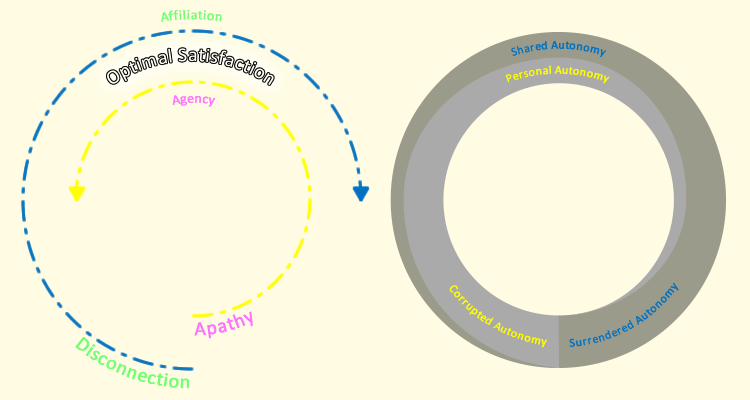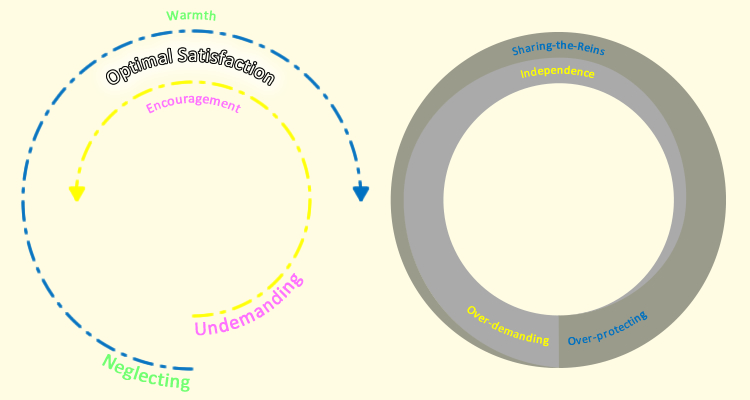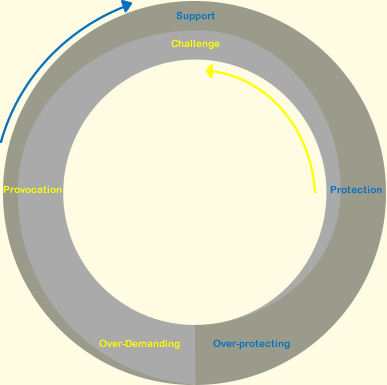Teacher Background
Optimising Support and Challenge
After 15 years of working on helping education staff support learner motivation and wellbeing, my conclusion is that a critical factor is the teachers' or lecturers' secure sense of self, being comfortable in their own skin. This allows and benefits from the teachers' or lecturers' capacity to self-reflect. Consequently we have developed this self-reflection tool for teachers and lecturers.
The Inspire Ring (Staff) consists of 72 descriptions that profile teaching style. It invites professional staff to rate the descriptions on how well they describe themselves on a six point scale. Those descriptions rated 3 and above are displayed within the Ring. The ring helps staff reflect on their attitude to learners by providing a framework to express what they may know intuitively about themselves but might not be able to put into words.
This is a reflection tool, not an assessment or a test. The array of questions gives the profile a degree of impartiality. It primes teacher to reflect on how they relate to learners and also to move in the right direction. The Inspire Ring gives immediate feedback in the form of a personal chart, allowing for a structured and focused discussion of key issues around how the teacher sees themselves and their relationship with learners. Ideally teachers should share their findings with someone they know well and trust, perhaps a 'critical friend' in their school or college.
The success of how lecturers/teachers motivate their learners is, in large part, down to how they relate to their learners, that is their Teaching Style. Teaching Style influences learner motivation and wellbeing by impacting on their motivating needs. The two foundational needs are Affiliation, to feel a sense of belonging and Agency, to feel a sense of progress. The third need is Autonomy, the need to be self-determining. Without compelling autonomy goals, learners can be sociable and competent but aimless and purposeless. It is their autonomy goals that give learners direction and motivation.
This model explores Autonomy through a new and powerful conceptualisation as having two distinct strands, namely Shared Autonomy and Personal Autonomy. These two strands are represented by two interlinking spirals. When one spiral balances the other we have balanced Autonomy. The spirals form the Ring of Autonomy.
Personal Autonomy is our need to assert our individuality and achieve status. It generates self-determination and propels us to maximise our strengths and personal achievement. Personal Autonomy is grounded in and, in turn, further develops Agency. Shared Autonomy is our need to contribute to something bigger than ourselves and have a sense of shared purpose. It generates cooperation and shared goals. Shared Autonomy grows naturally out of Affiliation, the foundation that allows us to build coalitions, and, in turn, Shared Autonomy deepens our Affiliation. Affiliation and Agency are discrete needs but can be thought of as embedded within their own Autonomy spiral, as displayed in Fig 1 below.
There are two potential pitfalls with Autonomy, when the spirals becomes imbalanced. These form the underside of the Ring. When we are driven by self-interest to get what we want, this is Personal Autonomy. However if we take this too far we can become selfish and domineering. Personal Autonomy can overpower Shared Autonomy and slide into Corrupted Autonomy, where we use and impose on others for our own ends. The dark side to Shared Autonomy is when we become undermined by too much accommodation to others, leading to acquiescence or Surrendered Autonomy.

The Inspire Ring maps out the main ways teachers/lecturers meet their learners' needs. These are the 'energising principles'. These principles and their darker undersides are presented in fig 2 below.

Warmth and Sharing-the-Reins offer the learner Support. Encouragement and Independence provide Challenge.
| Support | Challenge |
| Warmth Teachers are approachable and create a climate where learners feel they belong and are included. Partnership Teachers maximise learners’ sense of shared purpose and share the reins with them. There is a sense of give and take and working together in the teacher/learner relationship. |
Encouragement comes from achievable goals that set independence high. The teacher helps learners recognise their existing strengths and that progress is possible. Independence is built on boundaries and personal relevance Teachers establish authority and structure then give opportunities for responsibility and independent learning. |
The Inspire Ring aims to help teachers/ lecturers reflect on how they balance Support and Challenge. After completing the Aspire-Ring, a teacher's point on the ring represents how she or he resolves the tension between Support and Challenge. Each teacher's resolution can be adaptive or can become imbalanced in one of two directions, either towards being 'over-demanding' or 'over-protecting', as displayed in Fig 3 below. Provocation and protection are watershed points in either direction. We can provoke to get a reaction either for better or for worse and we can protect pupils to help meet their needs or to meet our own needs. A point on the Ring below these watersheds is an indication of a slide towards a negative impact on self and learners.

The Ring can be sub-divided into sections representing the Teaching Styles, as displayed in Fig 4 below.
The Hugging style priorities Support over Challenge, while still making the work interesting. The Squeezing style prioritises Challenge over Support, while still connecting sufficiently with learners.
The Inspiring style optimally blends Support and Challenge, drawing learners near to them and promoting interdependence, whilst at the same time making demands on learners in a way that helps them to feel proud of their progress. Inspirers get the balance right; they are not only strict and demanding but also warm and friendly; they are “warm demanders”.
If a teacher is having a ‘bad day’, their defensive reaction will be the excess of their ‘good day’ style.
- Posing - displays their expertise rather than building it in their learners.
- Pleasing -regularly goes off topic and may be indecisive.
- Bruising - overly provocative with low levels of Support, in other words being selfishly demanding.
- Smothering - over-protective and unable to direct learners appropriately.
- Resenting - shows indifference and lacks Warmth and Partnership.
- Fearing - devoid of Encouragement and Independence and at risk of putting learners off.
- Humiliating - can be the smothering 'pushover who eventually snaps and loses control, or in a more calculated way, it can happen when the Bruising teacher picks on a marginalised learner as a warning ‘pour encourager les autres’.
The styles are detailed in fig 4 below.

Effective teaching is all about ensuring both teachers’ and learners’ needs are met. This is a two-way process within which learners and teachers significantly impact on each others' morale. Teacher motivation is downloaded to learners. Learner motivation is, in turn, uploaded to teachers. While learners have a crucial role in creating the class climate and influencing staff morale, they have limited awareness of the teacher’s predicament and may not see their part in this dynamic. For example, they may think that grumpy teachers/ lecturers are just grumpy people.
Learners have much to contribute from their "lived in" perspective of classrooms. In any effective partnership, both parties must be able to raise issues concerning the quality of the relationship. Learners' views offer a necessary counter balance to any bias inherent in teacher perceptions.
The Inspire Ring enables teachers/lecturers to access learners’ views about how they are finding school. Asking learners for their opinions on your teaching is a powerful way to show respect for learners and will also develop their Autonomy as well as their understanding of the teacher/ learner relationship. Responding to learner feedback is a key driver that helps to promote a positive climate.
The Inspire Ring (Learner)
The Inspire Ring (Learner) consists of 36 paired descriptions that profile a teacher's teaching style. It invites learners to select the descriptions that best describe their teacher and then portrays their selections within the Ring.
When teachers plan to invite younger learners to complete the profile on their teaching style it will be useful, but not essential, to have a 'dry run' of the questions to check vocabulary and prime the class for the task. It will be important to make clear the purpose of the exercise, especially that you are inviting honest feedback to make you a better teacher and that it is anonymous. A useful warm up exercise is to ask learners if they think it would be a worthwhile for teachers to ask their learners for feedback from time to time. It is also useful to complete the Inspire Ring at a later date, as learners benefit from reflecting on the teacher's style after completing it the first time.
Follow Up
Highlight the % sores for Support and Challenge.
Compare the % scores for the styles.
Is there anything you are surprised by from the chart?
Consider whether the profile is accurate or not: you may feel that your place on the Ring should be changed. Change the chart if you can justify and evidence this.
Highlight your strengths. Asterisk your signature strengths, which you are most proud of.
Reflect on how your style may have developed/ changed over the years
Now look at the 'red flag' issues (boxed in chart). Underline one or two that you would like to work on, that would make the biggest difference. You may want to add a new issue if there one has not been identified.
Underline your main 'good day' and 'bad day' style.
Do your issues get you into difficulties? What defensive reaction do they get you into?
What will help get you out of this reaction?
Could any of your strengths help?
Imagine you woke up tomorrow and your issue had been sorted.
What’s the first thing you might notice you (and others) doing?
How will you know that things are improving?
Who would be the first to notice this had changed? How would they know? What will they see that is different?